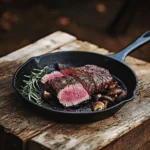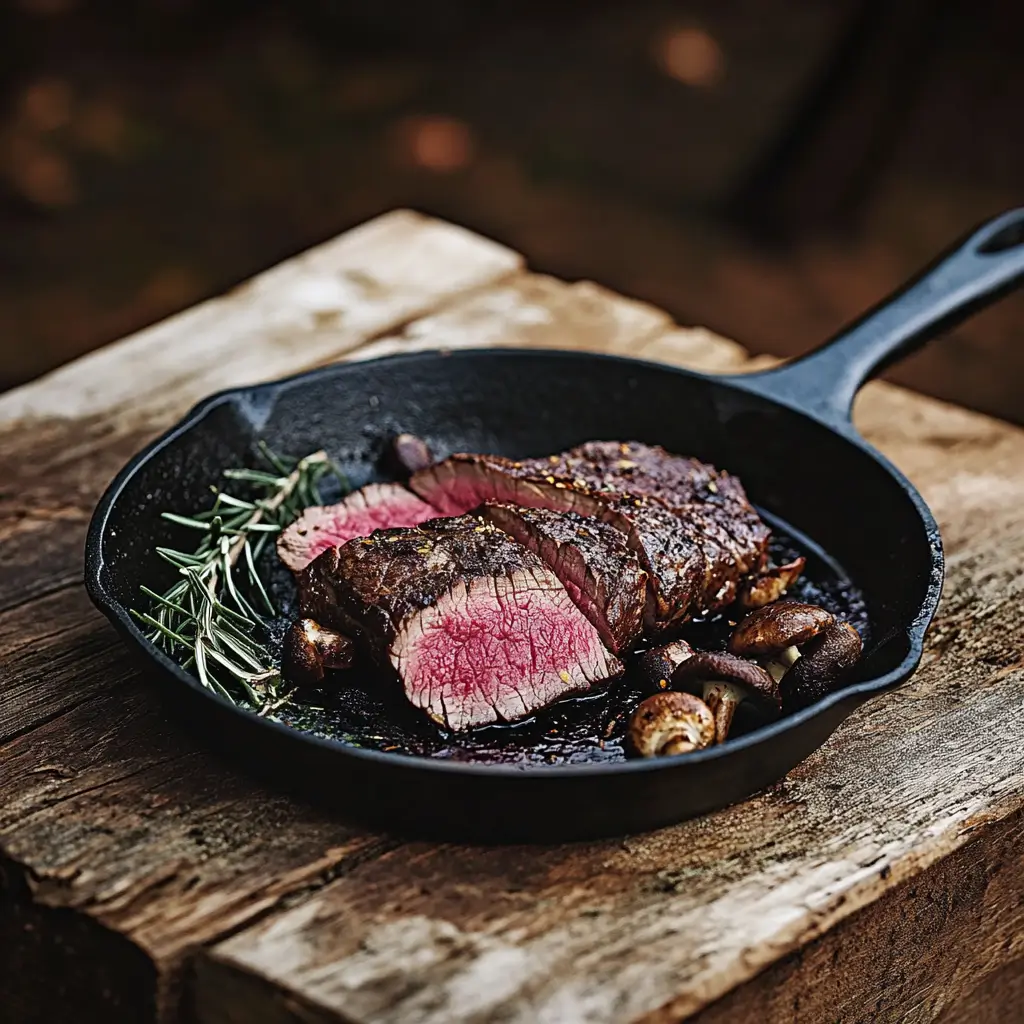Venison Backstrap Recipes
Are a true celebration of wild, lean, and flavorful meat. This prized cut from the loin of the deer is often compared to filet mignon for its tenderness—but with a taste that whispers of pine, frost, and field. Whether you’re grilling it under open skies or searing it in a cast-iron skillet, mastering this meat is both a skill and a joy. In this guide, you’ll learn the best ways to cook it, marinate it, and soak it—along with the reasons it’s a wholesome choice for your table.
And let me tell you—my love for this cut didn’t come from a cookbook. It started on a raw November morning, when my husband came in from the woods, boots muddy and hands full of gratitude. That afternoon, I stood by my grandmother’s cast-iron skillet, learning what real food tastes like. That first backstrap wasn’t just dinner—it was tradition sizzling in bacon grease. These venison backstrap recipes carry that same spirit. They’re simple, honest, and packed with the flavor of a life lived close to the land.
Table of Contents

Venison Backstrap Recipes That Truly Taste Like Home
- Total Time: 20 mins
- Yield: 4 servings
Description
A tender, juicy venison backstrap recipe full of rustic flavor, perfect for grilling or pan-searing on cozy nights at home.
Ingredients
– 1.5–2 lbs venison backstrap
– 2 tbsp olive oil
– 3 garlic cloves, crushed
– 2 sprigs fresh rosemary
– 1 tsp sea salt
– 1/2 tsp black pepper
– Optional marinade (soy sauce, balsamic, or buttermilk)
Instructions
1. Bring venison to room temperature
2. Pat dry and season generously
3. Heat grill or cast-iron skillet to high
4. Sear each side for 2–3 minutes
5. Check for 130°F internal temperature
6. Remove and rest for 10 minutes
7. Slice against the grain and serve
Notes
– Use buttermilk or a light brine if you prefer milder flavor
– Always slice against the grain
– Avoid overcooking—medium-rare is best
- Prep Time: 10 mins
- Cook Time: 10 mins
- Category: Wild Game
- Method: Grilling or Pan-Searing
- Cuisine: American Homestead
Nutrition
- Serving Size: 6 oz
- Calories: 210
- Sugar: 0g
- Sodium: 260mg
- Fat: 4g
- Saturated Fat: 1g
- Unsaturated Fat: 3g
- Trans Fat: 0g
- Carbohydrates: 0g
- Fiber: 0g
- Protein: 28g
- Cholesterol: 75mg
Keywords: venison backstrap, deer recipes, wild game, homestead cooking
Cooking Venison Backstrap
The Right Way to Cook It
When folks ask me how to cook deer backstrap so it stays tender and juicy, I always start with one piece of advice: don’t overcomplicate it. The best venison backstrap recipes use high heat, short cooking times, and just the right amount of rest to lock in that wild, woodsy flavor.
One of the most tried-and-true methods in my kitchen is the grill. For many of my favorite venison backstrap recipes, I simply bring the meat to room temperature, season it with salt, pepper, and garlic powder, and sear it over high heat. I aim for 2–3 minutes per side and pull it at 130°F. After a short rest under foil, it slices like butter and tastes like the forest floor in the best way.
When the snow’s falling and the grill’s tucked away, I switch to my cast-iron skillet. A little oil, a hot surface, and a quick sear on each side is all it takes. For thicker cuts, I slide the pan into a 375°F oven to finish for just a few minutes. This pan-sear method is the foundation for many homestyle venison backstrap recipes I make in the colder months.
Sous vide is another great tool, especially if you’re new to cooking wild game. It delivers consistent results every time. Season the meat, seal it with butter and herbs, and let it bathe in a 130°F water bath for a couple of hours. Finish it with a hot sear. This technique gives venison backstrap recipes a modern edge without losing the rustic feel.
Avoiding Common Mistakes
If there’s one thing I warn people about, it’s overcooking. Venison is naturally lean, and the backstrap doesn’t come with a safety net. That’s why every one of my venison backstrap recipes stresses pulling it off the heat early and letting it rest. Medium-rare is your friend.
Skipping the rest is another pitfall. Even a few minutes under a foil tent gives the juices time to settle. That short pause makes every slice juicier and every bite more rewarding.
Finally, always slice against the grain. I say it in nearly all of my venison backstrap recipes, because it makes a real difference in tenderness.
Whether you’re a first-timer or a seasoned cook, these methods are the backbone of reliable, flavorful venison backstrap recipes that you’ll come back to again and again.
Marinating & Soaking Venison Backstrap

Building Flavor the Right Way
There’s something sacred about the way marinade seeps into meat, especially when it’s wild game. For many of my venison backstrap recipes, a good marinade can turn a great cut into something unforgettable. The key is to add flavor without masking what makes venison so special.
One of my go-to marinades is a simple garlic-herb blend. A bit of olive oil, crushed garlic, rosemary, thyme, and a splash of lemon juice—just enough to brighten without overpowering. I let the backstrap rest in it for about 4 to 6 hours. This combination shows up in several of my venison backstrap marinade methods, especially when I’m pairing it with garden veggies or roasted roots.
When I want something heartier, I’ll reach for soy sauce, Worcestershire, and brown sugar. That blend adds umami and helps with caramelization on the grill. You’ll find this method woven through my grilled venison backstrap recipes, especially those I make for family cookouts or summer evenings by the fire.
If I’m after something earthy and bold, balsamic vinegar mixed with honey and a touch of Dijon mustard does wonders. That touch of sweetness pairs beautifully with the deep flavor of the backstrap.
Soaking to Tame the Wild
Sometimes, before the marinade goes on, I soak the meat—especially if I know it came from an older buck or spent time in the freezer. Many venison backstrap recipes start with a soak to soften the flavor and prepare the meat for seasoning.
My grandmother swore by buttermilk. It’s gentle, breaks down proteins, and draws out any strong or gamey notes. I usually let it sit in the fridge for about 6 to 12 hours, then rinse and pat it dry before cooking. It’s a quiet trick passed down through generations, and it shows up often in my homestead venison backstrap recipes.
Saltwater is another simple option. A basic brine made of water and sea salt helps clean the meat and firm it up. This method works well if you’re in a hurry and just need a quick prep before grilling.
Some folks use vinegar, and I’ll admit I do too—carefully. A bit of apple cider or white vinegar in cold water for an hour or two can lift the flavor without stripping it. Just don’t let it sit too long, or the meat can turn mushy.
No matter which route you take—soaking or marinating—these small steps help turn your venison backstrap recipes into dishes worth remembering.
Nutritional Benefits + FAQ + Conclusion
A Wholesome Cut with a Purpose
Beyond flavor and tradition, one of the reasons I keep venison backstrap in regular rotation is its nutrition. Many of the best venison backstrap recipes don’t just taste good—they do good for your body, too.
Venison is naturally lean. A 3.5-ounce portion of backstrap contains roughly 26 grams of protein and just 2–3 grams of fat. Compare that to beef tenderloin and you’ll find venison has fewer calories, less saturated fat, and more iron per bite. It’s clean, wild protein—no feedlots, no added hormones, just what the deer got from acorns, clover, and forest greens.
It’s also rich in zinc, B vitamins (especially B12), and selenium. That means better energy, stronger immunity, and support for everything from red blood cells to muscle repair. If you’re looking for meals that nourish while grounding you in nature, venison backstrap recipes are a powerful way to get there.
FAQ
What is the best way to cook the backstrap of a deer?
Grill or pan-sear it over high heat, aiming for medium-rare (130°F internal temp). Let it rest before slicing. This preserves the tenderness and flavor that makes backstrap so special.
What to marinate deer backstrap in?
Olive oil with garlic and herbs, soy-based blends, or balsamic vinaigrettes all work beautifully. Choose a marinade that complements the meat, not hides it.
What do you soak a deer backstrap in?
Buttermilk is most common, helping reduce gamey flavors and tenderize the meat. You can also use saltwater or diluted vinegar for quicker soaks.
Is a deer backstrap good for you?
Yes—venison backstrap is lean, high in protein, and full of vital nutrients like iron, B vitamins, and zinc. It’s one of the healthiest red meats available.
Conclusion
Cooking from the land teaches you more than just recipes—it teaches rhythm, patience, and gratitude. Venison backstrap recipes are a reflection of that. They remind us to honor what we’ve harvested, to share what we know, and to feed the people we love with purpose. Whether it’s your first deer or your fiftieth, your table can hold more than food—it can hold memory.
Now that you’ve learned how to cook, marinate, soak, and enjoy this treasured cut, I hope you’ll try a few of these ideas yourself. Keep it simple, trust the process, and let the meat speak for itself.
If you try one of these venison backstrap recipes or have a family tip to share, I’d love to hear from you. You can find me sharing more wild and garden-inspired meals over on Facebook and saving homestead favorites on Pinterest. Stop by anytime.

